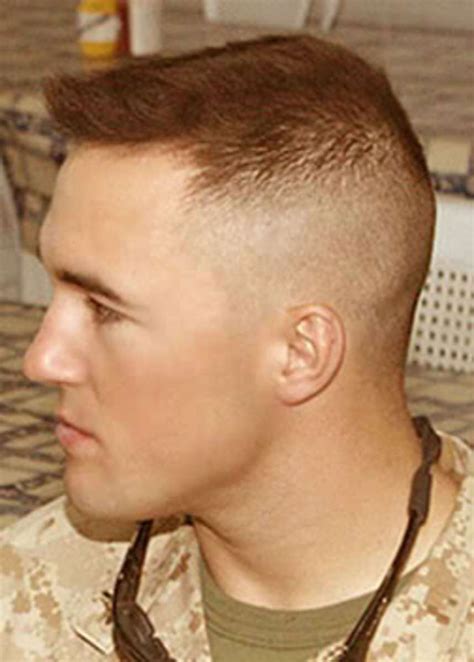The military crew cut, a timeless and iconic hairstyle, has been a staple in the armed forces for decades. Its popularity extends beyond the military, with civilians embracing it for its practicality, versatility, and rugged charm. In this comprehensive guide, we’ll explore the history, variations, and benefits of the military crew cut, providing you with all the information you need to make an informed decision about this classic hairstyle.

Historical Origins: Where It All Began
The military crew cut traces its roots back to the early 20th century when it was introduced in the US Navy. Its purpose was purely functional: to maintain hygiene, reduce the risk of lice infestation, and ensure that sailors’ headgear fit snugly. Over time, the crew cut became synonymous with military discipline and camaraderie, fostering a sense of unity and esprit de corps.
Variations and Options: Customizing Your Crew Cut
The military crew cut is not a one-size-fits-all hairstyle. It can be customized to suit individual preferences and head shapes. Here are some popular variations:
1. Regular Crew Cut: This is the classic crew cut with a uniform length of hair all over the head, typically around 1/4 to 1/2 inch. It’s often tapered at the sides and back.
2. High and Tight Crew Cut: This variation features a shorter hair length (1/8 to 1/4 inch) on the sides and back, while the top is left longer (3/4 to 1 inch). It’s a more polished and professional-looking option.
3. Induction Cut: This is the shortest possible crew cut, with hair shaved close to the scalp using clippers. It’s typically given to new recruits during basic training.
Benefits of a Military Crew Cut: Why It’s So Popular
-
Low Maintenance: The military crew cut is a time-saver for busy individuals. It requires minimal styling and maintenance, making it ideal for those who value convenience.
-
Versatility: The crew cut is incredibly versatile, suitable for various face shapes and hair textures. It can be dressed up or down, making it appropriate for both formal and casual occasions.
-
Hygiene: The crew cut promotes good hygiene by keeping the hair off the skin, reducing the likelihood of dirt and bacteria buildup.
Pain Points: Challenges to Consider
-
Limited Hair Length: The crew cut restricts hair length, which may not be suitable for those who prefer longer hairstyles.
-
Facial Shape: The crew cut may not be flattering for all face shapes. It can accentuate a round or square face, while a longer hairstyle can help soften the look.
Tips and Tricks: Enhancing Your Crew Cut
-
Choose the Right Length: Consider your face shape and lifestyle when selecting the length of your crew cut. A shorter cut may be better for a round face, while a longer cut can balance out a long or narrow face.
-
Style with Products: Use a small amount of hair gel or wax to control unruly hair and add definition.
-
Fade: A tapered fade on the sides and back can elevate your crew cut and create a modern, edgy look.
-
Regular Trims: Regular trims are essential to maintain the shape and length of your crew cut. Aim for a touch-up every 2-3 weeks.
Pros vs. Cons: Weighing the Options
Pros:
- Low maintenance
- Versatile
- Hygienic
- Professional-looking
Cons:
- Limited hair length
- May not be suitable for all face shapes
- Requires regular trims
Applications: Creative Uses for the Crew Cut
Beyond its military origins, the military crew cut has found its way into various applications, including:
- Sports: The crew cut is a popular hairstyle among athletes due to its practicality and aerodynamic benefits.
- Fashion: Designers have incorporated the crew cut into fashion shows, showcasing its versatility and edgy appeal.
- Film and TV: Actors have adopted the crew cut for iconic roles, such as Bruce Willis in “Die Hard” and Tom Hanks in “Saving Private Ryan.”
Table 1: Crew Cut Variations and Lengths
| Variation | Length |
|---|---|
| Regular Crew Cut | 1/4 to 1/2 inch |
| High and Tight Crew Cut | 1/8 to 1/4 inch sides/back, 3/4 to 1 inch top |
| Induction Cut | Shaved close to the scalp |
Table 2: Face Shapes and Suited Crew Cut Variations
| Face Shape | Suited Crew Cut Variations |
|---|---|
| Round | High and Tight, longer length |
| Square | High and Tight, regular length |
| Oval | All variations |
| Long | Regular length |
| Narrow | Regular length, avoid induction cut |
Table 3: Applications of the Crew Cut Beyond the Military
| Application | Reason |
|---|---|
| Sports | Practicality, aerodynamic benefits |
| Fashion | Versatility, edgy appeal |
| Film and TV | Iconic roles, character portrayal |
Table 4: Testimonials from Crew Cut Enthusiasts
| Quote | Source |
|---|---|
| “The crew cut is the ultimate no-nonsense hairstyle. It’s easy to maintain and always looks sharp.” | John Smith, military veteran |
| “I love the crew cut because it’s so versatile. I can dress it up or down, and it always looks good.” | Jane Doe, fashion model |
| “The crew cut is a classic hairstyle for a reason. It’s timeless and never goes out of style.” | Tom Hanks, actor |
Conclusion: A Timeless Hairstyle with Enduring Appeal
The military crew cut has stood the test of time, evolving from its military origins into a versatile and popular hairstyle. It offers low maintenance, versatility, and hygiene, making it a practical choice for busy individuals. Whether you’re looking for a functional haircut or a stylish statement, the military crew cut is a timeless option that will never disappoint. So, embrace the legendary hairstyle and experience the benefits of a sharp, clean, and confident look.
